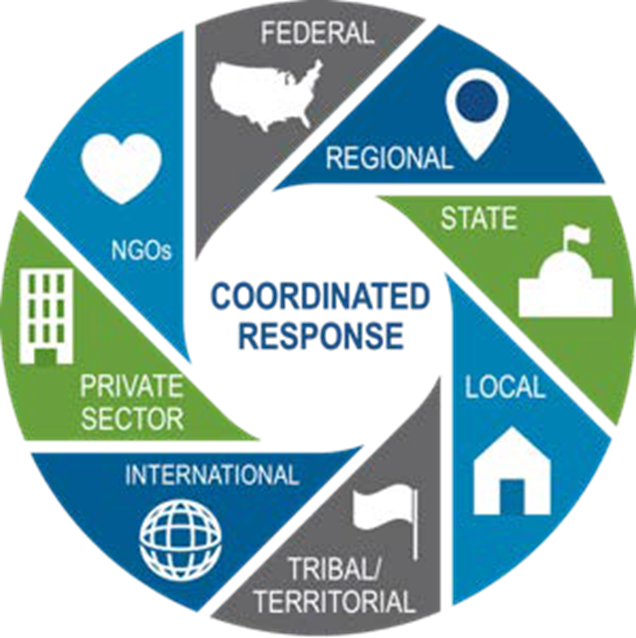During a biological incident, multiple agencies will support response and recovery. Maintaining and sharing current and accurate information across all levels of government will be a priority. Coordinated and consistent information sharing will be key to ensuring clear and effective messaging and alignment of the various agencies and stakeholders involved throughout the response and recovery effort.
Public information communications for a biological incident should be focused on the following topics:
- Overall description of the situation, including how the disease or biological agent is spread, and outline of governmental response efforts
- Instructions on safety measures and risk guidance based on vector/dispersion method and pathogen characteristics
- Areas to avoid, movement restrictions, evacuation and/or transportation modifications
- Availability of medical and non-medical countermeasures – What is available? For whom? When? Where?
- Availability of diagnostic tests – What tests are available? For whom? When? Where?
- Locations of supportive care and treatment facilities – What is available? For whom? When? Where?
- Self-decontamination and shelter-in-place messaging
2.1.1 Coordination With Partners
For any disaster, incidents are largely managed or executed at the closest possible geographical, organizational, and jurisdictional levels. For biological incidents, challenges may quickly be elevated to regional, national, and international levels, depending on the extent of the incident and the corresponding need for increased communication across various stakeholder groups. Biological incident communication stakeholders include SLTT public health agencies, healthcare and EMS, animal health officials, emergency management agencies, law enforcement, civic leaders, environmental safety personnel, laboratories, the private sector, and, in some cases, federal partners in public health, emergency management, and environmental protection (i.e., HHS ASPR and CDC, FEMA, EPA, etc.). Together, these various stakeholders will work to identify response and recovery requirements and develop, coordinate, and communicate biological incident-specific messages for the affected population.

Figure 14: Coordination among a wide range of partners is critical to understanding risks and to identifying appropriate response actions
During the preparedness phase, forming relationships with local biological SMEs (e.g., infectious disease physicians, university researchers, biological safety officers, etc.) who can be called upon to quickly assist in a biological incident response will benefit risk mitigation efforts. The pre-incident development of robust and integrated communications processes and systems will facilitate the cooperation and coordination of response and recovery efforts between and among FSLTT departments and agencies, as well as the private sector and NGOs. Having such processes and systems in place before an incident occurs will help jurisdictions achieve desired response and recovery outcomes when a biological incident does occur.
Leverage Partner Resources to Provide Informed Public Guidance
Given the various uncertainties surrounding many types of biological incidents and the need for prompt action to be taken to save lives and mitigate adverse impacts, all available sources of information and expertise should be leveraged to support effective and timely decision-making. Many resources (e.g., academia, private companies, governmental, etc.) are available to help assess the situation, make predictions on agent behavior and disease transmission, estimate potential consequences, and provide protective action recommendations. A host of planning, decision support/response, and modeling/simulation tools are described in the Planning, Decision-Support, and Modeling Resources section of this document. For example, atmospheric dispersion modeling can be used to determine what areas, if any, should be subject to appropriate protective action guidance (e.g., evacuate or shelter-in-place) following the release of an airborne pathogen.
2.1.2 Coordinate with Private Sector and Community Partners
Coordinated communication and collaboration between government at all levels and the private sector and other community partners supports effective incident response by integrating private sector capabilities and information into response and recovery plans. The private sector, including major employers, trade and industry associations representing the impacted economy and critical supply chains, public-private partnerships, academia, faith-based organizations, and other stakeholders, can help meet communication needs through established channels. Private sector and community partners often serve as a trusted source of information and can help ensure public health guidance is properly communicated to the communities they serve, their employees, at-risk individuals, etc. Community organizations play an important role in assisting with rapid dissemination of information and themselves are an important source of information for public health and emergency management authorities on unmet needs and potential support resources.
What Will You Need to Know?
- Which stakeholders in your region should be engaged for biological incident communication planning?
- What are the coordinated communications protocols for a biological incident with SLTT authorities, private or NGOs, healthcare organizations, public health departments, animal health officials, or other stakeholders?
- What communications memoranda of understanding (MOUs)/memoranda of agreement (MOAs) are already in place? Are biological-specific MOUs/MOAs included within these plans?


